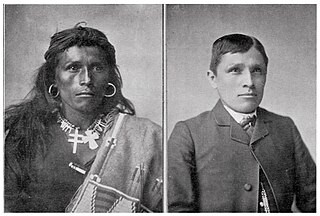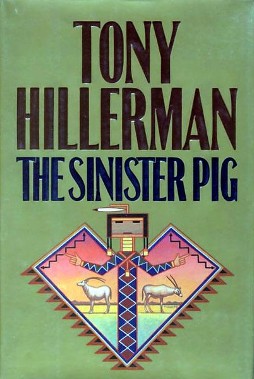
The Navajo Nation, also known as Navajoland, is an Indian reservation of Navajo people in the United States. It occupies portions of northeastern Arizona, northwestern New Mexico, and southeastern Utah. The seat of government is located in Window Rock, Arizona.

Tribal sovereignty in the United States is the concept of the inherent authority of Indigenous tribes to govern themselves within the borders of the United States.
Indigenous peoples of Arizona are the Native American people who currently live or have historically lived in what is now the state of Arizona. There are 22 federally recognized tribes in Arizona, including 17 with reservations that lie entirely within its borders. Reservations make up over a quarter of the state's land area. Arizona has the third largest Native American population of any U.S. state.

An American Indian reservation is an area of land held and governed by a U.S. federal government-recognized Native American tribal nation, whose government is autonomous, subject to regulations passed by the United States Congress and administered by the United States Bureau of Indian Affairs, and not to the U.S. state government in which it is located. Some of the country's 574 federally recognized tribes govern more than one of the 326 Indian reservations in the United States, while some share reservations, and others have no reservation at all. Historical piecemeal land allocations under the Dawes Act facilitated sales to non–Native Americans, resulting in some reservations becoming severely fragmented, with pieces of tribal and privately held land being treated as separate enclaves. This intersection of private and public real estate creates significant administrative, political, and legal difficulties.

The Navajo or Diné, are a Native American people of the Southwestern United States.

A series of efforts were made by the United States to assimilate Native Americans into mainstream European–American culture between the years of 1790 and 1920. George Washington and Henry Knox were first to propose, in the American context, the cultural assimilation of Native Americans. They formulated a policy to encourage the so-called "civilizing process". With increased waves of immigration from Europe, there was growing public support for education to encourage a standard set of cultural values and practices to be held in common by the majority of citizens. Education was viewed as the primary method in the acculturation process for minorities.

The California Department of Fish and Wildlife (CDFW), formerly known as the California Department of Fish and Game (CDFG), is an American state agency under the California Natural Resources Agency. The Department of Fish and Wildlife manages and protects the state's wildlife, wildflowers, trees, mushrooms, algae and native habitats (ecosystems). The department is responsible for regulatory enforcement and management of related recreational, commercial, scientific, and educational uses. The department also prevents illegal poaching.

The United States Department of Justice Environment and Natural Resources Division (ENRD) is one of seven litigating components of the U.S. Department of Justice. ENRD's mandate is to enforce civil and criminal environmental laws and programs protecting the health and environment of the United States, and to defend suits challenging those laws and programs.

The Sinister Pig is a crime novel by American writer Tony Hillerman, the sixteenth in the Joe Leaphorn/Jim Chee Navajo Tribal Police series, first published in 2003. It was a New York Times best-seller.

Peter MacDonald is a Native American politician and the only four term Chairman of the Navajo Nation. MacDonald was born in Arizona, U.S. and served the U.S. Marine Corps in World War II as a Navajo Code Talker. He was first elected Navajo Tribal Chairman in 1970.
Native American self-determination refers to the social movements, legislation and beliefs by which the Native American tribes in the United States exercise self-governance and decision-making on issues that affect their own people.
The Project on Indigenous Governance and Development, previously named the Harvard Project on American Indian Economic Development, also known as the Harvard Project, was founded in 1987 at Harvard Kennedy School at Harvard University. It administers tribal awards programs as well as provides support for students and conducting research. The Harvard Project aims to understand and foster the conditions under which sustained, self-determined social and economic development is achieved among American Indian nations through applied research and service.
Merrion v. Jicarilla Apache Tribe, 455 U.S. 130 (1982), was a case in which the Supreme Court of the United States holding that an Indian tribe has the authority to impose taxes on non-Indians that are conducting business on the reservation as an inherent power under their tribal sovereignty.
The Council of Energy Resource Tribes (CERT) is a consortium of Native American tribes in the United States established to increase tribal control over natural resources. Americans for Indian Opportunity, led by LaDonna Harris (Comanche), convened the tribes originally and helped to facilitate the creation of CERT. It was founded in September 1975 by twenty-five tribes under the leadership of the Navajo Nation under chairman Peter McDonald.
The Utah Dineh Corporation is a nonprofit organization which was established in order to maintain the Utah Navajo Oil Reserve revenues in the Aneth Oil Field section of Utah. Much of this area is within the Utah Navajo side of San Juan County, Utah.
The Kayenta mine was a surface coal mine operated by Peabody Western Coal Company, a subsidiary of Peabody Energy) on the Navajo Nation in northern Arizona from 1973 to 2019. About 400 acres were mined and reclaimed each year, providing about 8 million tons of coal annually to the Navajo Generating Station.
Kerr-McGee v. Navajo Tribe, 471 U.S. 195 (1985), was a case in which the Supreme Court of the United States held that an Indian tribe is not required to obtain the approval of the Secretary of the Interior in order to impose taxes on non-tribal persons or entities doing business on a reservation.
Williams v. Lee, 358 U.S. 217 (1959), was a landmark case in which the Supreme Court of the United States held that the State of Arizona does not have jurisdiction to try a civil case between a non-Indian doing business on a reservation with tribal members who reside on the reservation, the proper forum for such cases being the tribal court.

The impact of the COVID-19 pandemic on Native American tribes and tribal communities has been severe and has emphasized underlying inequalities in Native American communities compared to the majority of the American population. The pandemic exacerbated existing healthcare and other economic and social disparities between Native Americans and other racial and ethnic groups in the United States. Along with black Americans, Latinos, and Pacific Islanders, the death rate in Native Americans due to COVID-19 was twice that of white and Asian Americans, with Native Americans having the highest mortality rate of all racial and ethnic groups nationwide. As of January 5, 2021, the mortality impact in Native American populations from COVID-19 was 1 in 595 or 168.4 deaths in 100,000, compared to 1 in 1,030 for white Americans and 1 in 1,670 for Asian Americans. Prior to the pandemic, Native Americans were already at a higher risk for infectious disease and mortality than any other group in the United States.









